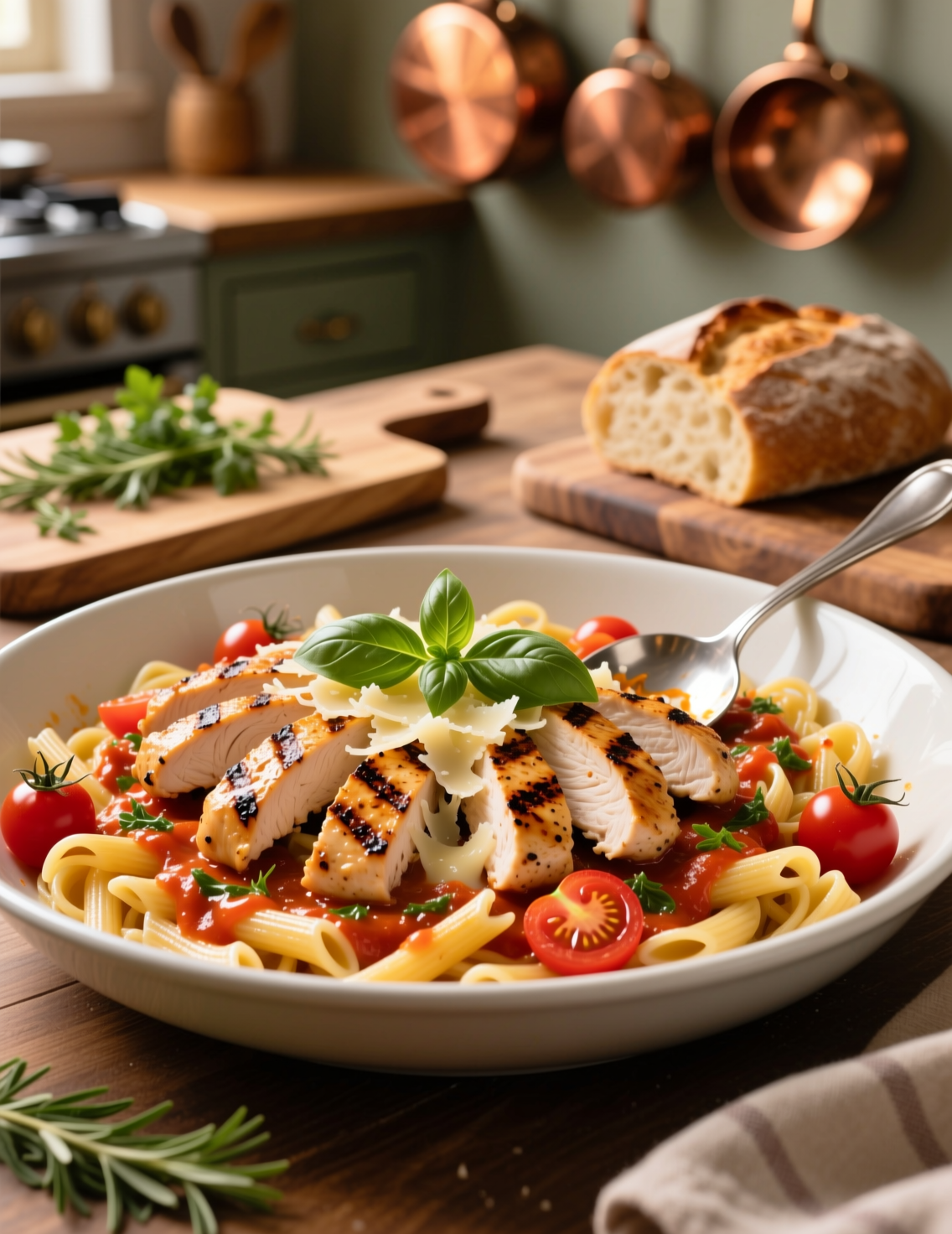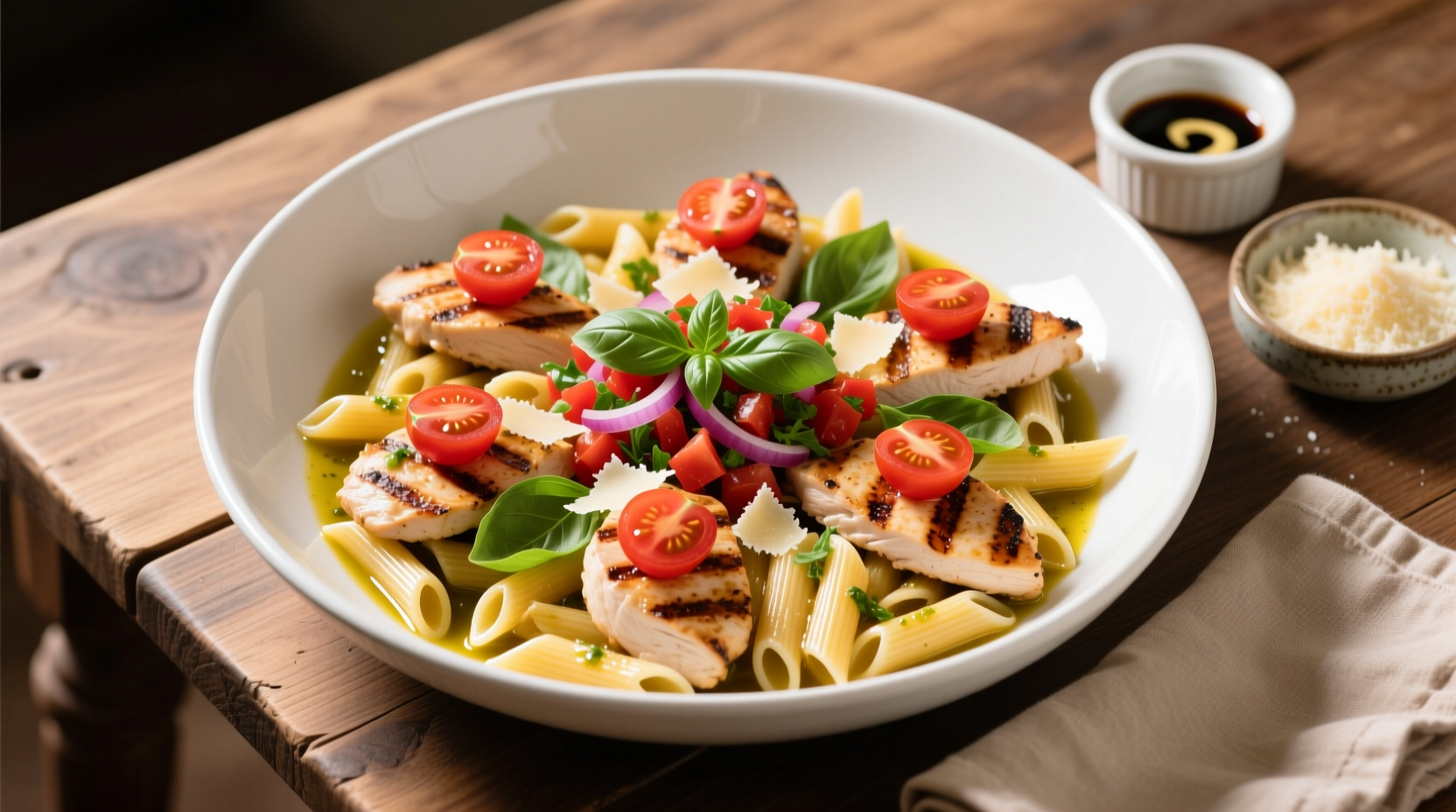Bruschetta chicken pasta is not just another chicken-and-pasta dinner. It’s a bright, fragrant dish that pulls together rustic Italian flavors with a modern edge. For professional cooks, this recipe holds value because it balances efficiency, scalability, and a flavor profile that feels both comforting and refined. Let’s dive into how to craft this dish for six servings, with attention to detail that separates a cook from a chef.
Why Bruschetta Chicken Pasta Works
The idea of bruschetta—grilled bread rubbed with garlic, topped with fresh tomato, olive oil, and basil—translates surprisingly well to pasta. When you marry those elements with seared chicken, the result is fresh yet filling. The acidity of tomatoes cuts the richness of the pasta and chicken. The basil keeps things light, while a drizzle of good extra virgin olive oil finishes everything with warmth.
In professional kitchens, dishes like this serve another role: they bridge rustic simplicity with customer expectations of sophistication. Diners want something familiar but still a bit elevated. This recipe delivers.
Ingredients That Define the Dish
For six servings, you need:
- 1½ pounds boneless, skinless chicken breasts (about 3 medium)
- 16 ounces penne or spaghetti (dry weight)
- 4 cups cherry tomatoes, halved
- 6 cloves garlic, finely minced
- 1 cup fresh basil leaves, torn by hand
- ½ cup freshly grated Parmesan cheese
- ½ cup extra virgin olive oil (split use)
- 3 tablespoons balsamic vinegar
- 2 teaspoons kosher salt (plus more for pasta water)
- 1 teaspoon black pepper
- Pinch of red pepper flakes (optional, but recommended)
These ingredients are classic, but the devil hides in the quality. A tomato that’s underripe will collapse the dish’s brightness. Basil that’s wilted? You’ve lost the perfume. A professional must source produce as carefully as proteins.
Preparing the Chicken
Chicken breasts are prone to overcooking. Pound them gently to even thickness—about ¾ inch is ideal. This ensures uniform cooking and prevents dry, stringy meat.
Heat a skillet until shimmering, then add olive oil. Sear the chicken until golden, about 4–5 minutes per side, depending on thickness. You want that Maillard reaction working hard here; caramelization equals flavor. Rest the chicken before slicing, because cutting too soon will bleed out juices like a leaky faucet.

Pasta: More Than Just a Base
The pasta should be treated with equal respect. Professionals know pasta water is liquid gold. Always salt it generously—think ocean-salty. This seasons the pasta from the inside out, rather than relying only on sauces.
Cook until al dente. Not mushy, not raw—there’s a tightrope here. Save at least 1 cup of pasta water before draining. This starchy water will later emulsify the sauce, clinging to pasta in a way olive oil alone can’t.
The Bruschetta Mix
Cherry tomatoes are the heroes. They should macerate briefly with garlic, balsamic, olive oil, and salt. This step extracts juices that will act as the base of the pasta “sauce.” It’s more of a dressing than a sauce, but when warmed with pasta water, it coats every bite.
Some chefs roast the tomatoes lightly to intensify sweetness. Others keep them raw for freshness. Both approaches have merit, but for six servings, raw maceration saves time and maintains that bruschetta authenticity.
Marrying the Elements
Once pasta is drained, return it to the pot. Toss with the bruschetta mix and just enough pasta water to create a silky coating. Add sliced chicken on top, Parmesan, basil, and more olive oil. Toss lightly. Resist the urge to overmix; bruising basil leaves turns them black and bitter.
Serve in warm bowls. Garnish with extra basil, Parmesan shavings, and a drizzle of olive oil.
Professional Insights
Bruschetta chicken pasta isn’t just about flavors—it’s about balance. Acid versus fat. Protein versus starch. Fresh herbs versus cooked aromatics.
For catering or restaurant service, consider portioning into shallow bowls with high rims. This traps aromas and visually elevates the dish. At scale, this recipe adapts well because pasta can be cooked in advance and shocked in cold water, then reheated in sauce before service. Chicken can be grilled ahead, chilled, and sliced thin for faster plating.
Nutritional Profile
A 6-serving batch provides a balanced meal. Each serving roughly contains:
- Calories: ~560
- Protein: 36g
- Carbohydrates: 48g
- Fat: 21g
It’s hearty enough for dinner service, yet lighter than cream-based pasta dishes. For health-conscious diners, it reads as indulgent without guilt.
Variations That Work
- Gluten-Free: Substitute pasta with chickpea pasta for added protein.
- Low-Carb: Replace pasta with spiralized zucchini; keep bruschetta and chicken intact.
- Roasted Garlic Twist: Roast whole garlic cloves instead of using raw for a sweeter, mellow flavor.
- Cheese Upgrade: Replace Parmesan with Pecorino Romano for sharper bite.
Restaurants often experiment with smoked mozzarella or burrata added just before serving. This transforms the dish into something bordering luxury.
Common Mistakes
- Overcooking Chicken: Leads to dryness and stringy texture. Use an instant-read thermometer—165°F is safe.
- Underseasoning Pasta Water: Pasta carries most of the dish’s bulk; bland pasta equals bland dish.
- Skipping Pasta Water: Without it, the sauce won’t cling. Instead, it pools sadly at the bottom of the plate.
- Overmixing Basil: Black basil not only looks unattractive but tastes harsh.
Case Study: Scaling for Service
In a mid-sized Italian bistro, this dish was introduced as a summer special. On weekends, 45+ orders were served per night. Prep staff pre-macerated tomatoes in large stainless bowls, while line cooks grilled chicken in batches. Pasta was cooked par-cooked (about 70%), then finished à la minute in boiling water. This reduced ticket times by nearly 30%.
Customers praised its freshness, and the dish achieved a 20% higher re-order rate compared to heavier Alfredo-based pastas. This demonstrates its value not just as a recipe but as a menu strategy.
Trends and Future Potential
Dishes like bruschetta chicken pasta align with current dining trends—lighter pastas, Mediterranean flavors, and customizable builds. With diners increasingly seeking meals that feel both indulgent and wholesome, this dish positions perfectly.
Chefs experimenting with heirloom tomatoes or infused olive oils are adding seasonal flares. Some restaurants serve it family-style in large bowls, encouraging communal dining. This trend resonates with younger diners who value shared experiences over solitary plates.
Expert Recommendations
- Always source tomatoes in-season for peak flavor. Out of season, use high-quality canned cherry tomatoes, slightly drained.
- Invest in finishing olive oil. A peppery, grassy oil adds dimension beyond basic supermarket brands.
- For plating, don’t bury chicken under pasta. Let it shine on top, fanned out for visual appeal.
Conclusion
Bruschetta chicken pasta for six servings isn’t simply a recipe—it’s a lesson in balance, technique, and respect for ingredients. Professionals should treat each step, from macerating tomatoes to searing chicken, with intention. Done correctly, the result is a dish that pleases casual diners and impresses discerning guests alike.
The beauty of this dish lies in its simplicity. Few ingredients, clear technique, and flexibility for adaptation. That’s why it belongs not only in home kitchens but also on professional menus.
FAQs
How many servings does this bruschetta chicken pasta recipe make?
It makes 6 generous servings, perfect for a family or small group.
What type of pasta works best for this recipe?
Penne or spaghetti works best, but any sturdy pasta will hold the sauce well.
Can I prepare the chicken ahead of time?
Yes, you can grill or sear it ahead and slice just before mixing.
Do I need to peel the tomatoes for the bruschetta mix?
No, cherry tomatoes work perfectly with skins on.
Why is pasta water important in this dish?
It helps emulsify the sauce, making it cling smoothly to the pasta.
Can I make this recipe gluten-free?
Yes, simply swap regular pasta with gluten-free or chickpea pasta.
What’s the best way to keep chicken juicy?
Cook evenly to 165°F and rest before slicing to retain juices.
Can I roast the tomatoes instead of leaving them raw?
Yes, roasting intensifies their sweetness and adds depth of flavor.
How can I make this dish lighter?
Use zucchini noodles or whole wheat pasta instead of regular pasta.
What cheese works as a substitute for Parmesan?
Pecorino Romano is a sharper alternative, while burrata adds creaminess.
Is this dish good for meal prep?
Yes, store components separately and assemble when ready to serve.
What olive oil should I use?
A good quality extra virgin olive oil enhances flavor significantly.
How do I stop basil from turning black?
Add it at the very end and avoid overmixing into hot pasta.
Can I serve this dish cold?
Yes, it makes a refreshing pasta salad when chilled.
How long does it take to make this recipe?
It takes about 35–40 minutes from prep to plating.

Mariana is a passionate home cook who creates delicious, easy-to-follow recipes for busy people. From energizing breakfasts to satisfying dinners and indulgent desserts, her dishes are designed to fuel both your body and hustle.
When she’s not in the kitchen, she’s exploring new flavors and dreaming up her next recipe to share with the Foodie Hustle community.

